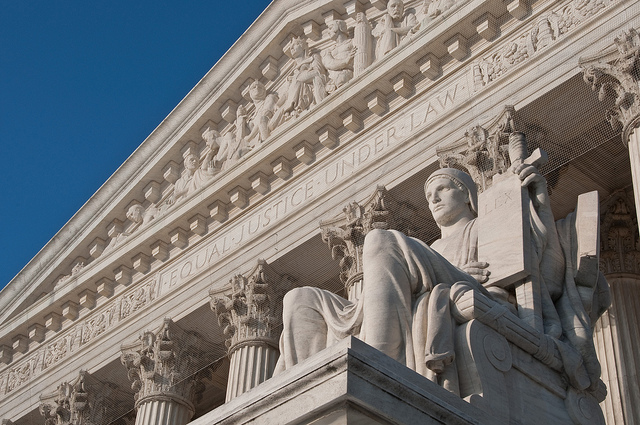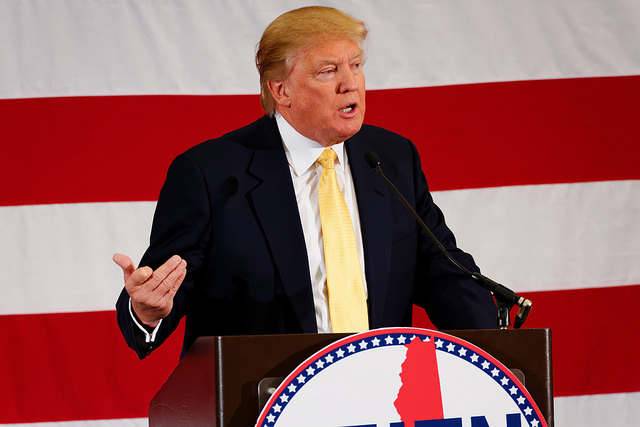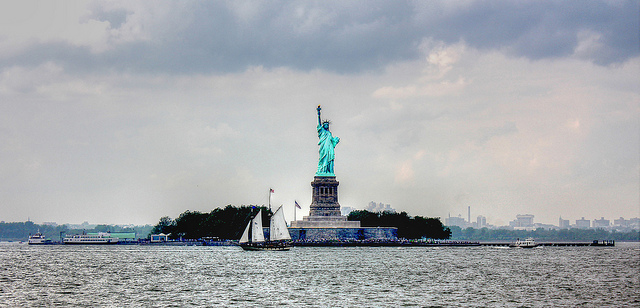The Year Ahead for American Politics on Immigration
“Give me your tired, your poor, your huddled masses yearning to be free.” So goes the exemplary quote inscribed on the Statue of Liberty. Since that iconic bronze statue was dedicated in New York Harbor 140 years ago, millions of immigrants entering the United States have viewed it as a symbol of the freedom, wealth and opportunities that awaited them ashore.
In the 19th century, immigrants from Ireland, Germany, Italy and China comprised the bulk of those passengers. For the 21st century, Syrian and Iraqi refugees appear to be the next wave to crash upon America’s shores. Since the Syrian civil war erupted in 2011, an estimated 11 million refugees have fled the that country; this crisis was compounded in 2014 with the meteoric rise of ISIS as people fled the self-proclaimed Sunni caliphate and its oppressive regime.
Traditionally Americans have held an equivocal opinion when it comes to welcoming foreigners into their borders—from New England’s anti-Catholic Know Nothing party of the 1850s to today’s armed vigilante patrolling the Mexican border. Why should 2016 be any different? Travel a thousand miles due west from New York City and you’ll encounter the remaining frenzy from the rambunctious Iowa caucus where more than a dozen presidential candidates recently clashed over the issue.
Senator Ted Cruz and former Secretary of State Hillary Clinton may have won the first political round in the Hawkeye State, but their campaigns are far from over. On top of a litany of policy issues, candidates still have to propose solutions for Syrian refugees and the millions of illegal immigrants before the race is over in November.
The Syrian Question
The Syrian refugee crisis that has engulfed Europe is now beginning to move from American television sets into their own backyards, creating a new debate on immigration reform. Politicians in Washington, however, aren’t waiting for a new commander in chief in order to enact legislation on the Syrian issue at hand.
Last December, Republicans in the House of Representatives pushed through a bill that sought to stem the flow of refugees from Syria and Iraq into the country. Proposing some of the strictest enforcement measures on refugees from these countries, the bill called for security clearances from the nation’s top security offices, including Homeland Security, FBI and National Intelligence. Proponents of the measure hoped that tighter restrictions would prevent would-be terrorists from posing as refugees.
“Senior law enforcement and intelligence officials have expressed concerns, and [Homeland Security] Secretary Jeh Johnson has said that “organizations such as [ISIS] might like to try to exploit this program,'” said Senate Majority Leader Mitch McConnell.

In the Photo: Syrian refugees debarking at Lesbos, Greece. Photo Courtesy: Freedom House.
Although President Obama had threatened to veto the bill if it reached his desk, this action was spared by Senate Democrats who successfully blocked the measure, 55-43—five votes short of the necessary 60 for a bill to advance to the executive office. With the measure dead on the floor, the president announced plans to admit an additional 10,000 Syrian refugees into the country this year. Nonetheless, the proposal isn’t popular according to most Americans. A recent New York Times poll found that 55 percent of the country disapproves of the president’s immigration policy compared to 37 percent that approve.
While President Obama is free to ignore such polls during his last year in office, his Republican rivals are less inclined to do so. Three of the Republican candidates running for president took a break from campaigning to return to Capitol Hill to vote in favor of the immigration bill. Senate Minority Leader Harry Reid also attempted to use the presidential election to his party’s advantage: allowing the bill to pass the Senate if Senate Republicans denounced presidential hopeful Donald Trump’s stance on immigration, which has jarred much of the nation and the media; Senate Republicans declined the offer.
In his first year as House Speaker, Paul Ryan said, “By blocking this measure, Senate Democrats are making it that much harder for us to keep Americans safe.”
D.R.E.A.M. On?
The immigration issue shifted to a new front in early January when the Supreme Court of the United States decided to hear an appeal in which a lower federal court had blocked President Obama’s executive order on illegal immigration.
In November of 2014, the president expanded upon the existing Deferred Action for Childhood Arrivals (DAPA) by postponing the deportation of illegal immigrants who are under the age of 16 — or “dreamers” — for three years instead of the mandated two. In a controversial inclusion to the order, President Obama attached a separate program to DAPA that would have provided undocumented parents of American citizens the same benefits as legal residents.
“I have said time and time and time again to Congress that, send me the DREAM Act, put it on my desk and I will sign it right away,” President Obama said in a statement. “In the absence of any immigration action from Congress to fix our broken immigration system, what we’ve tried to do is focus our immigration enforcement resources in the right places. The Department of Homeland Security is taking steps to lift the shadow of deportation from these young people.”

The Supreme Court will decide whether to uphold President Obama’s executive order on DAPA in June. Photo Courtesy: Mark Fischer.
Arguing that the president’s order would impose excessive new costs in areas such as health care, law enforcement and education, dozens of states filed suit against it. In February of 2015, Judge Andrew S. Hanen of a federal district court in Brownsville, TX filed a preliminary injunction that halted the program until the legal process was completed. The White House appealed, but the injunction was upheld by the United States Court of Appeals in New Orleans.
“As federal courts have already ruled three times, there are limits to the President’s authority, and those limits enacted by Congress were exceeded when the President unilaterally sought to grant ‘lawful presence’ to more than 4 million unauthorized aliens who are in this country unlawfully,” Texas Attorney General Ken Paxton said in a statement. “The Court should affirm what President Obama said himself on more than 20 occasions: that he cannot unilaterally rewrite congressional laws and circumvent the people’s representatives.”
President Obama is reported to have motioned for an early decision on the case. The court appears to have sustained the president’s request and has decided to hear the arguments in April. A decision can be expected in June, allowing the ruling to influence the remainder of the contested presidential race.
Democratic presidential nominee Hillary Clinton has already stated that she plans to uphold her predecessor’s immigration programs if they survive the Supreme Court. Conversely, many of the Republican contenders have vowed to dismantle Obama’s policies and instead double down on immigration enforcement and border security.
Meanwhile on the Campaign Trail…
Of course those running for the nation’s highest office don’t have to wait for the Supreme Court to make its final decision to push their own immigration policies. The issue has been particularly contentious for the Republican presidential candidates and a frequent talking point for much of the debates thus far.
Donald Trump has made immigration his highest priority. From the debate floor to sold-out theaters, he has continued to deliver long diatribes on how he plans on deportation plans for all of the 12 million illegal immigrants, temporarily barring Muslims from entry into the country, and constructing a more robust wall on the Mexican border.
“As has been stated continuously in the press, people are pouring across our borders unabated,” Trump said last June. “Public reports routinely state great amounts of crime are being committed by illegal immigrants. This must be stopped and it must be stopped now.”

In the Photo: Republican presidential contender Donald Trump at a rally in Nashua, NH. Photo Courtesy: Michael Vadon.
Trump’s chief rival and the winner of the Iowa caucus, Ted Cruz, has gone further in his immigration rhetoric by calling for an end to birthright citizenship — whereby any child of an American citizen is an American citizen by right. Cruz’s stance on this subject is peculiar in that he himself is an American citizen by birthright, being born in Canada to a Cuban father and an American mother.
On the other side of the debate, the Democratic presidential contenders have dismissed their partisan opponents as being racist and xenophobic. In addition to supporting President Obama’s existing immigration policies, Secretary Hillary Clinton has promised to include undocumented children in college tuition and health care programs. “We have to finally and once and for all fix our immigration system,” Clinton states on her campaign’s website. “This is a family issue, it’s an economic issue too, but it is at heart a family issue.”
In a televised town hall forum in New Hampshire, Senator Bernie Sanders, Clinton’s sole rival in the Democratic primary, told the audience that he would also allow Syrian and Iraqi refugees into the nation.
Boats Against the Current
In 1882 — four years before the Statue of Liberty was unveiled in New York — the United States government enacted the Chinese Exclusion Act. The law prohibited Chinese immigrants from entering the country for ten years and was made permanent twenty years later.
Since the Chinese Exclusion Act was repealed in 1943, Chinese and other immigrants that identify as being Asian have become one of America’s most successful demographics. According to a 2014 report by the Bureau of Labor Statistics, 60 percent of Asian Americans aged 25 or older had attained a bachelor’s degree. Compared to Caucasian (38 percent), African American (27 percent) and Hispanic (19 percent) groups, Asians Americans are the highest educated demographic in the country, while also having the lowest level of unemployment at about 5 percent.
Immigration success stories such as these are an excellent example of the American dream in action, and although few politicians today propose ending screening processes for foreigners entering the country, it’s increasingly harder to argue against blocking immigration out right.
 The Statue of Liberty was dedicated in New York Harbor 140 years ago. Photo Courtesy: Mobilus In Mobili via Flickr.
The Statue of Liberty was dedicated in New York Harbor 140 years ago. Photo Courtesy: Mobilus In Mobili via Flickr.
If Republicans continue to preach and support anti-immigration rhetoric as they have, the party is likely to struggle in national elections as more immigrants and the children of immigrants comprise more of the general population. Conservative politicians, in the vain hope of preserving their present electoral majority, must choose to either adapt to America’s evolving demographics or continue to bombast immigration entirely—the later of which, according to many policy experts, is considered political suicide.
On the other hand, if Democrats are capable of balancing immigration reform with recent national security concerns, then the party can expect growth and success in years to come. However, as current polls and the national attitude stand, 2016 will be no easy victory for either Hillary Clinton or Bernie Sanders, regardless of the forward-thinking immigration proposals they support.
_ _



 The Statue of Liberty was dedicated in New York Harbor 140 years ago. Photo Courtesy: Mobilus In Mobili via Flickr.
The Statue of Liberty was dedicated in New York Harbor 140 years ago. Photo Courtesy: Mobilus In Mobili via Flickr.






